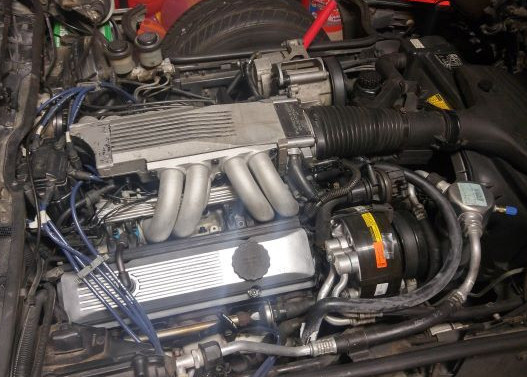
The year 1985 marked the second year of the fourth generation or C4 Corvette. A better fuel injection system was introduced to the Corvette for the year 1985. The Tuned Port Injection system replaced Cross Fire Injection from 1984. The L98 was the new designation for the updated 350 cubic-inch engine. During its lifetime, this engine underwent minor modifications to tweak its horsepower. The Tuned Port Injection (TPI) improved 350 small-block’s fuel economy and performance.
Below is are some engine changes made by year.
The beginning – 1985
The 5.7-liter, small-block V-8, had overhead valves with cast-iron blocks. 4.0 x 3.48 inches was the bore and stroke of the engine, while 9.0:1 was the compression ratio. The L98 produced 230 horsepower at 4,000 rpm and 330 foot-pounds of torque at 3,200 rpm. Compared to previous carburetor systems and cross-fire injection systems, the Tuned Port Injection system improved performance by 30 percent. TPI worked by injecting fuel into each cylinder and was controlled by a mini computer called the Electronic Control Module. This new TPI system delivered low emissions and excellent fuel efficiency. My 1985 gets near 30 miles per gallon on the highway with over 100k on the clock.
The L98’s induction system gave new life to the old tried and true design. The air intake was ahead of the radiator, away from engine heat. Inducted air passed over the mass airflow sensor, through the throttle body, and into the intake plenum. Eight cast-aluminum runners ran down under the fuel rails and connected to an aluminum intake manifold. An upgraded and newly powerful computer controlled air, fuel, and ignition.
The engine power differences between the ’84 and ’85 cars were dramatic, with the 1985 now capable of a top speed of 150-mph. That speed pushed the C$ to be the fastest base Corvette to date.
Click here to see the different horsepower numbers by year.
1986 L98 Changes
For the next few years, incremental improvements were made to the L98. For the first time since the 1975 production year a convertible model was offered in 1986. The new convertible came with new aluminum heads that brought a 40-pound engine weight savings and a 5hp output improvement. These improvements were made by an increase in the compression ratio from 9.0:1 to 9.5:1. Midway through 1986, all models came with aluminum heads for improved engine performance.
Out on the track, the highly reliable, torquey L98 C4 Corvette proved practically unbeatable, earning itself an eventual ban from the SCCA’s Showroom Stock class and a creation of its own class for C4 Corvettes.
1987 L98 Improvements
In 1987, the L98 on the Corvette received roller hydraulic valve lifters and low restricted mufflers were added which boosted horsepower up to 240 at 4,000 rpm. Torque increased to 345 foot-pounds at 3,200 rpm. Also, in 1987, General Motors made the L98 available in the Chevrolet Camaro. The L98 Camaro was rated at 225 horsepower at 4,400 rpm with 330 foot-pounds at 2,800 rpm. The L98 on the 1987 Camaro IROC Z28 did 0 to 60 in 6.6 seconds, compared to 6.2 seconds by the Corvette.
1988 Final updates
In 1988, the L98 was tweaked for the last time on the Corvette. Modified aluminum cylinder heads were installed onto the engine, which allowed the engine to breathe better, and an adjusted camshaft was installed. The modifications boosted horsepower by 5. The updated L98 had an output rating of 245 at 4,000 rpm and the torque stayed the same. Road and Track tested the 1988 Corvette and recorded 6.0 seconds in its 0 to 60 test.
There were no new changes to the 1989 L98 but the 1990 Corvettes had reported horsepower as high as 250hp thanks to some slight revisions and a return to speed density air metering.
The L98 was such a great design that it was the basis for the Callaway Twin-Turbo Corvette.
Conclusion
The L98 was retired at the end of the 1991 model year. During the 7 years of existence the L98 was a proven performer, very reliable and got great gas mileage too. The L98 was the grandfather of all the LS motors that came after.
But before the LS family of engines was created another stepping stone was the LT1 C4 engine which became standard in 1991. A tribute to the LT-1 from the early 1970s pushed the Corvette C4 back into the 300 horsepower range.
For a table of all C4 Corvette engines and performance numbers on a sortable table, check out my page here.

